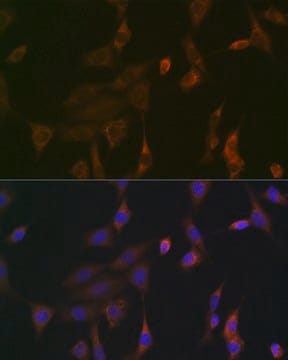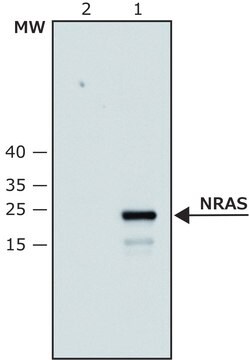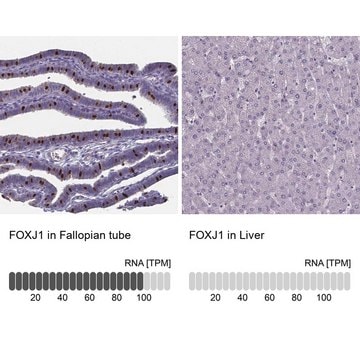推荐产品
生物源
mouse
共軛
unconjugated
抗體表格
purified immunoglobulin
抗體產品種類
primary antibodies
無性繁殖
polyclonal
形狀
buffered aqueous solution
分子量
antigen ~20.79 kDa
物種活性
human
技術
proximity ligation assay: suitable
western blot: 1 μg/mL
NCBI登錄號
UniProt登錄號
運輸包裝
dry ice
儲存溫度
−20°C
目標翻譯後修改
unmodified
基因資訊
human ... HRAS(3265)
一般說明
Harvey rat sarcoma viral oncogene homolog (HRAS) is a member of the Ras oncogene family. The HRAS gene is mapped to human chromosome 11p15.5 and is expressed in different isoforms. HRAS comprises a conserved G domain and a hypervariable region. The G domain, in turn, contains switch I and II domains. It also harbors the secondary signal domain and the CAAX motif. The HRAS protein is localized to the Golgi membrane.
免疫原
HRAS (NP_005334, 1 a.a. ~ 189 a.a) full-length human protein.
Sequence
MTEYKLVVVGAGGVGKSALTIQLIQNHFVDEYDPTIEDSYRKQVVIDGETCLLDILDTAGQEEYSAMRDQYMRTGEGFLCVFAINNTKSFEDIHQYREQIKRVKDSDDVPMVLVGNKCDLAARTVESRQAQDLARSYGIPYIETSAKTRQGVEDAFYTLVREIRQHKLRKLNPPDESGPGCMSCKCVLS
Sequence
MTEYKLVVVGAGGVGKSALTIQLIQNHFVDEYDPTIEDSYRKQVVIDGETCLLDILDTAGQEEYSAMRDQYMRTGEGFLCVFAINNTKSFEDIHQYREQIKRVKDSDDVPMVLVGNKCDLAARTVESRQAQDLARSYGIPYIETSAKTRQGVEDAFYTLVREIRQHKLRKLNPPDESGPGCMSCKCVLS
應用
Anti-HRAS antibody produced in mouse has been used in western blotting.
生化/生理作用
Harvey rat sarcoma viral oncogene homolog (HRAS) exists as guanosine triphosphate (GTP)-bound form when associated with non-ordered lipid domains. However, with the lipid rafts of the plasma membrane, HRAS is present in a guanosine diphosphate (GDP)-bound state. It regulates the signaling events in a wide variety of cellular processes. Germline mutations in the HRAS gene results in Costello syndrome, a disease with cardiovascular abnormalities, growth deficiency, and musculoskeletal abnormalities. The HRAS gene defects are also implicated in the pathophysiology of many tumors including epithelial-myoepithelial carcinoma (EMC), thyroid, oral squamous cell carcinoma, and bladder cancer.
外觀
Solution in phosphate buffered saline, pH 7.4
免責聲明
Unless otherwise stated in our catalog or other company documentation accompanying the product(s), our products are intended for research use only and are not to be used for any other purpose, which includes but is not limited to, unauthorized commercial uses, in vitro diagnostic uses, ex vivo or in vivo therapeutic uses or any type of consumption or application to humans or animals.
Not finding the right product?
Try our 产品选型工具.
儲存類別代碼
10 - Combustible liquids
水污染物質分類(WGK)
WGK 1
閃點(°F)
Not applicable
閃點(°C)
Not applicable
Sònia Guil et al.
Cancer research, 63(17), 5178-5187 (2003-09-23)
We characterized a novel protein of the Ras family, p19 (H-RasIDX). The c-H-ras proto-oncogene undergoes alternative splicing of the exon termed IDX. We show that the alternative p19 mRNA is stable and as abundant as p21 (p21 H-Ras4A) mRNA in
Christian P Kratz et al.
Human molecular genetics, 16(4), 374-379 (2006-12-14)
Costello syndrome (CS; MIM 218040) is characterized by short stature, facial dysmorphism, cardiac defects and predisposition to embryonal rhabdomyosarcoma (CS/ERMS) and other neoplasias. CS is caused by germline mutations in the HRAS gene on chromosome 11p15.5, a region showing allelic
Lihua Shu et al.
Molecular cancer therapeutics, 19(4), 999-1007 (2020-04-04)
H-Ras is a unique isoform of the Ras GTPase family, one of the most prominently mutated oncogene families across the cancer landscape. Relative to other isoforms, though, mutations of H-Ras account for the smallest proportion of mutant Ras cancers. Yet
Anne-Mette Hartung et al.
PLoS genetics, 12(5), e1006039-e1006039 (2016-05-20)
Costello syndrome (CS) may be caused by activating mutations in codon 12/13 of the HRAS proto-oncogene. HRAS p.Gly12Val mutations have the highest transforming activity, are very frequent in cancers, but very rare in CS, where they are reported to cause
Makoto Urano et al.
The American journal of surgical pathology, 43(7), 984-994 (2019-04-18)
Epithelial-myoepithelial carcinoma (EMC) is a rare salivary gland tumor that is histologically characterized by biphasic tubular structures composed of inner ductal and outer clear myoepithelial cells. Because of its histologic variety, it is sometimes challenging to make an accurate diagnosis
我们的科学家团队拥有各种研究领域经验,包括生命科学、材料科学、化学合成、色谱、分析及许多其他领域.
联系技术服务部门







